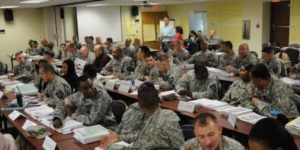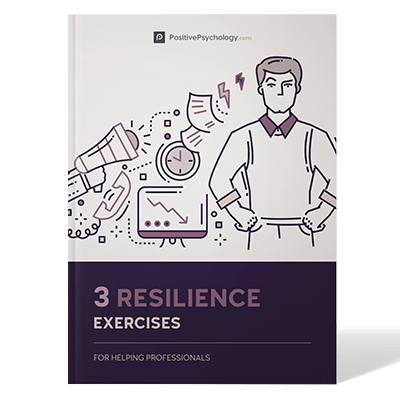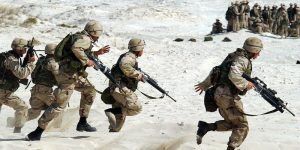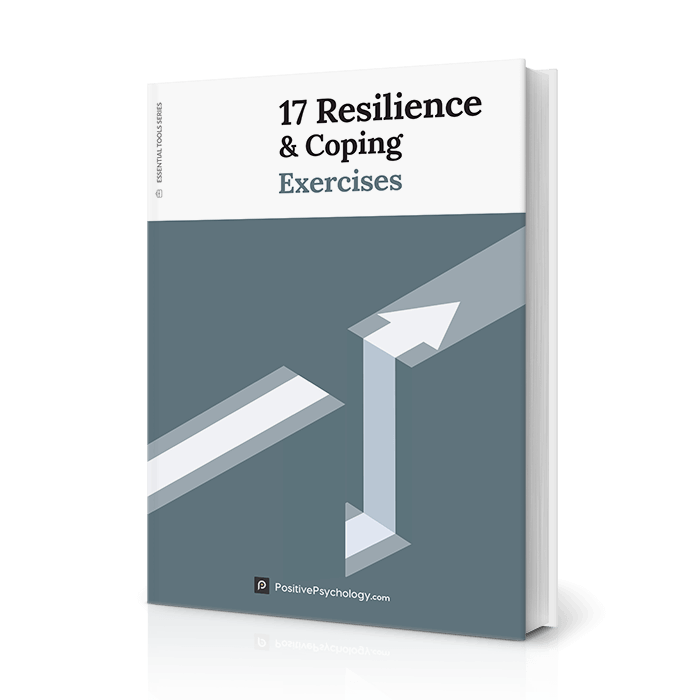

The United States Army is the most senior branch of the eight-armed defense services of the United States.
Many of its members have endured stresses we could never comprehend.
Have you ever wondered how the Army prepares future soldiers for these stressors? How do they train soldiers to remain calm while facing extreme situations? And ultimately, how do they help these soldiers cope afterward?
Surely from such rigorous training, we can take pieces from their program to benefit our own clients and organizations.
To that end, in this article we review the Master Resilience Training (MRT) program to answer each of these questions. We will also share our discussion with an experienced program instructor and a slide presentation accompanying the robust MRT training.
Before you continue, we thought you might like to download our three Resilience Exercises for free. These engaging, science-based exercises will help you effectively deal with difficult circumstances and give you the tools to improve the resilience of your clients, students, or employees.
Resilience is “the process of adapting well in the face of adversity, trauma, tragedy, threats, or even significant sources of threat” (Zhang et al., 2022, p. 577). It is critical that soldiers be not only physically fit, but also psychologically fit. So how does this robustly resilient entity ensure its members are psychologically fit?
They use the US Army Master Resilience Training (MRT).
This 10-day course prepares soldiers and civilians to develop their own resilience and teach others. Participants are immersed in large group sessions, small group work, and partner and individual exercises that introduce the six competencies explained below. Fourteen distinct skills accompany the implementation of these competencies.
Is this program effective?
In a study by Griffith and West (2013), 611 resilience-trained Army National Guard soldiers and civilians completed online questionnaires about their resilience training experience, and their responses suggest it is effective.
Participants showed the following positive outcomes as a result of resilience training (Griffith & West, 2013):
The MRT includes six competencies:
These six competencies are critical characteristics of a resilient individual.
The preparation component of the MRT train-the-trainer course comprises five separate modules, while the sustainment and enhancement components each consist of their own modules. This means that the entire MRT train-the-trainer program consists of seven different modules taught over the course of 10 days.
These modules, in the order that they are taught and paired with a brief description, are (Reivich et al., 2011):
The curriculum used in MRT is grounded in the field of positive psychology and derived from many of the materials developed by the University of Pennsylvania and the Penn Resilience Program.
Similar to the Comprehensive Soldier Fitness program and contrary to traditional approaches, MRT is proactive. In other words, this program establishes methods of improving resilience for all members instead of addressing the negative outcomes of stress after the fact (Cornum et al., 2011). Personal growth is the ultimate goal.
Army Regulation 350-1 mandates that all soldiers receive this training. Select soldiers, civilians, and spouses have the opportunity to get certified to train the troops at lower echelons in the train-the-trainer course. These individuals can then share their learning with fellow soldiers and family members upon return to their unit.
Perhaps you are a visual learner and would benefit from viewing a slide presentation about this training. You could also modify this presentation to fit your organization’s needs.
The presentation summarizes the entire MRT program and includes a synthesis of each module and what it comprises.
For further reading, you may want to browse this Resource and Activity Guide created by the US Army.
Click here to access this presentation.

While we worked hard to provide a useful description of MRT, there is no replacement for a description from someone who has actually gone through the program.
Fortunately, we have been in touch with an MRT trainer who has taught the program for years and was generous enough to share his experiences with us in this interview.
Chaplain (Captain) Mike MacKrell is an expert in MRT and truly enjoys sharing its lessons with his fellow soldiers in the Army.
He kindly took some time out of his busy schedule to give us insight into the inner workings of the program, which he has taught to soldiers and civilians alike. If you want to learn about MRT, this is an excellent place to continue your education.
For clarity’s sake, the questions we sent to Chaplain (Captain) MacKrell have been numbered. His answers are directly under the corresponding questions, and a quick wrap-up written by us (not him) follows the questions.
Please enjoy this interview about MRT with one of its proponents, and we can only hope that you learn as much from reading this interview as we did by conducting it.
1. How did you become an MRT trainer?
“I was on active duty standing up a resilience team to serve our soldier and family population where I was stationed and needed to get an overview and understanding of the program. I enrolled in the class, and I am an ardent follower from the start.”
2. What aspect of MRT has stuck with you the most?
“Because of my love for soldiers and everything that has to do with psychology, I was all-in from the start. The material has affected my life in so many good ways. The material provides basic working models that apply to situations and contexts we all find ourselves in. It is not a cure-all, but a framework for approaching life.”
3. What was the easiest part of MRT to teach?
“One of the first modules I learned was ‘Hunt the Good Stuff’ — a module designed to augment optimism and fight the negativity bias we all possess. I had just received a life-altering email, and because of the place I was in, the material saved me from self-loathing and catastrophizing. No joke. The planets aligned for me that day.”
4. What was the hardest?
“The most difficult module for me initially was entitled ‘Problem Solving.’ Due to the emotional and relational nature of the news I received, I was transferring so much of me into the training and thus became unable to objectivize the problem sufficiently to really listen and face my circumstances.
“Now, eight years later, I can share what I have learned and do a much better job at teaching that portion of the training. The practice has made me a better learner and teacher.”
5. How well do MRT’s teachings translate to civilians?
“Very well I believe, if your view of life, like mine, is broader than just wearing a military uniform. Because I entered the military later in life, my experiences are mostly on the civilian side. I have heard and concur with many MRTs that seeing the material’s utility in a broader sense is a more useful approach than just applying it to the rhythms of military service.”
6. Are there any difficulties in teaching it to civilians compared to soldiers (or vice versa)?
“Depends on your mindset and sensitivity to life outside the military. If a trainer is reluctant or resistant to get to know their audience (which may be both civilian and military), I think they limit their ability to instruct, persuade, and apply life lessons that are easily understood by all.”
7. How is MRT unique compared to other things soldiers are taught in the Army?
“Other than the curriculum used in the Army’s ‘Strong Bonds’ program (marriage enrichment and single soldier and family material), it is one of the better programs of instruction the Army has ever had. Obviously, I am biased.”
8. In what ways have you found it easier to teach MRT as you have gathered more experience doing so?
“After practicing this for eight years, I can now share both success and failure stories with participants from my own desire to apply what I have learned in my life and significant relationships.”
9. Is there any advice you would give somebody teaching MRT for the first time?
“Do your homework long before your first class. Read more than just the footnotes. Get with other MRTs and get their help and insights. Soldiers are quickly turned off by slide clickers — trainers who merely read the slide and don’t have a conversational experience using the material. This helps no one. Approach your audience as co-learners. Refuse to pontificate. Be vulnerable with your audience and learn from them as well.”
10. What was your experience learning about MRT for the first time?
“It was wonderfully incredible. I guess I was in the right frame of mind and came to the table at the right time.”
11. Is there anything else you would like to share about MRT itself or your experiences teaching MRT?
“It has been my privilege to familiarize and train this curriculum with soldiers and civilians in the Middle East on two deployments, in the Czech Republic two different times, and on many civilian bases. Every time I am up to bat, my preparation yields new insights. I have been the beneficiary far more than anyone I have spoken with. If a trainer is stoked and fired up about how it has made a difference in their life, you can’t argue with the life change.”
Final thoughts
Chaplain (Captain) Mike MacKrell has taught MRT to soldiers and civilians around the world and learns something new every time he teaches it. We hope this insight into an MRT trainer’s mind has helped you learn something new as well.

It is no surprise that soldiers are asked to perform dangerous work, resulting in an elevated risk of developing psychological disorders (Sefidan et al., 2021).
Although not every service member is actively involved in wartime activities, peacetime prepares soldiers for combat. This training can be equally as stressful. Therefore, resilience is of the utmost importance for troop preparation. This mental toughness must be present from the very beginning.
During training, soldiers’ physical and emotional limits will be pushed, in turn strengthening their physical and mental fitness. Resilience will be key to soldiers’ success in combat situations and extreme survival scenarios.
In a review of 25 studies, Griffith and West (2013) concluded that up to 20% of soldiers involved with deployments and combat operations develop post-traumatic stress disorder and related symptoms. Resilience training can help prevent and address these mental health issues in soldiers (Griffith & West, 2013; Thompson & Dobbins, 2018).

These detailed, science-based exercises will equip you or your clients to recover from personal challenges and turn setbacks into opportunities for growth.
Download PDF
By filling out your name and email address below.
Just as in many other professions, healthcare workers also face an elevated amount of stress.
Joyce et al. (2022) conducted a mixed-method analysis of the effectiveness of a skill-based coaching program employed to decrease stress and increase resilience. One hundred and fifty-three healthcare workers took part in the Promoting Resilience in Stress Management (PRISM) program.
The researchers’ findings suggest that implementing a resilience-promoting curriculum is helpful. Further, the PRISM program was associated with improved self-reported resilience and decreased stress and burnout (Joyce et al., 2022).
Resilience and the possible benefits of resilience training are especially applicable to high-risk professions, which include the military, medical workforce, and first responders (Joyce et al., 2018).
Habitual exposure to trauma is common within such workforces, which leads to elevated rates of mental health problems.
Joyce et al. (2018, p. 8) conducted a thorough literature review of resilience training and determined that certain types of resilience training can modify these predictor variables; therefore, it is wise to “consider whether those entering careers such as medicine, nursing, policing, paramedicine or firefighting should be provided with resilience training.”
Considering this research on civilians and the obvious benefits of resilience programs in general, the need for preventing and mitigating the effects of trauma on the US Army military personnel is profound (Thompson & Dobbins, 2018).

The Positive Psychology Toolkit© is a groundbreaking practitioner resource containing over 500 science-based exercises, activities, interventions, questionnaires, and assessments created by experts using the latest positive psychology research.
Updated monthly. 100% Science-based.
“The best positive psychology resource out there!”
— Emiliya Zhivotovskaya, Flourishing Center CEO

To become an MRT trainer in the US Army, you must attend and complete the MRT course; however, there are stipulations before even attending this prestigious course.
An individual must be a soldier (non-commissioned or commissioned officer) or a Department of the Army civilian. Soldiers and civilians must have a certain amount of time remaining in their positions and have passed the Army Combat Fitness Test if it applies to them.
Spouses may also have the unique opportunity to attend. Further, candidates must have excellent communication and presentation skills. Please refer to this link for a list of specific criteria.
To become a resilience trainer outside of the Army, the University of Pennsylvania offers train-the-trainer programs. In these programs, participants learn how to teach the skills to others to build their organization’s internal training capabilities. The duration of the train-the-trainer programs is five to seven days.
The Resilient Mind offers various trainings and is certified by the Substance Abuse and Mental Health Services Administration’s National Registry of Evidence-Based Programs and Practices. Used in over 27 countries, this organization works closely with the International Coaching Federation.
Although you may not be able to take the US Army-offered MRT course, you are welcome to peruse their training site here, which contains a substantial number of resources, videos, infographics, and actionable strategies for a variety of stressors that may apply to you or your clients.
Some of my personal favorites include:
The University of Pennsylvania offers the Penn Resilience Program and PERMA workshops (two interchangeable terms for the same set of programs), strengths-based programs that can be delivered virtually or in person. The workshops equip individuals with practical skills that can be applied in everyday life to thrive in challenging environments and navigate adversity.
Recognized by media outlets such as The Wall Street Journal, Forbes, The New York Times, and WebMD, Resilience Trainer provides training in the SMART, The Resilient Option, and CeRT programs developed by Dr. Sood, who has two decades of experience and research.

Empower others with the skills to manage and learn from inevitable life challenges using these 17 Resilience & Coping Exercises [PDF], so you can increase their ability to thrive.
Created by Experts. 100% Science-based.
Are you looking for an already-created high-quality, science-based training program you can do online? The Realizing Resilience Masterclass© may be the comprehensive training template you need. This Masterclass guides you through six modules to help you and your clients build resilience skills.
The program offers a ready-to-go method for applying positive psychology in your training. It teaches you how to give clients an intuitive way to share experiences and provides you with hands-on tools to implement these methods in your classes.
This training will assist you in building your repertoire of resilience skills and help you become a sought-after resilience expert.
If you’re not quite ready yet to sign up for the masterclass, consider this collection of 17 validated resilience and coping exercises. Use them to help others recover from personal challenges and turn setbacks into opportunities for growth.
As a recap, Master Resilience Training is critical for today’s military. Master Resilience Training marries positive psychology with the modern soldier’s issues. It is beneficial because it is not a reactionary approach; it is preventive.
While we may not all have the opportunity to take part in the Master Resilience Training program offered by the US Army, we can gain much insight from its focus on such a critical character trait as resilience.
Provided in this article are several opportunities and resources for resilience. In many professions, resilience is imperative. Up to 90% of individuals will experience at least one serious traumatic event during their lives, so it is vital we understand the factors involved in resilience to support clients or teach others more healthy coping mechanisms (Southwick & Charney, 2012). The US Army is no exception.
We hope you enjoyed reading this article. Don’t forget to download our three Resilience Exercises for free.
References